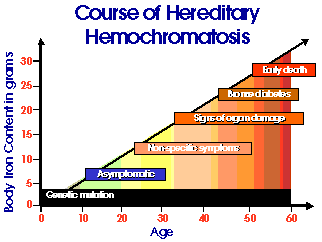Background
In the United States iron overload is primarily due to a genetic
disorder known as hereditary hemochromatosis. Hemochromatosis is
characterized by lifelong excessive absorption of iron from the
diet, with iron accumulating in body organs, eventually causing
inflammation and damage. Serious and even fatal health
effects can result, including cirrhosis of the liver, liver
cancer, heart abnormalities (leading to heart failure), diabetes,
impotence, and arthritis. Approximately one of every 200 to
400 people is affected, while one in 10 is a carrier making this
one of the most common of the known genetic disorders in the U.S.
The availability of diagnostic tests for serum iron
|
 |
| measures and
the recent discoveries of the genetic mutations responsible for
hemochromatosis provide the potential for early detection. However, the social, ethical, and legal implications of such
genetic testing and screening are only beginning to be explored.
|
Treatment
by periodic removal of iron (by blood removal, or phlebotomy) is
safe and effective, and can lead to a normal life expectancy if
initiated before organ damage has occurred. Early detection
and treatment for this genetic condition can lessen morbidity and
mortality, and in some cases prevent the onset of disease.
Therefore, early detection of hemochromatosis represents a major
chronic disease prevention opportunity. Hereditary hemochromatosis
is often referred to as a model for formulating policy decisions
about genetic-associated diseases.
CDC
Program Activities
|
|
Examine
laboratory quality assurance for serum iron measures
|
|
|
Validate
diagnostic tests and assess their usefulness in diagnosis and
screening |
|
|
Educate
health care providers about the importance of early diagnosis
and treatment |
|
|
Educate
patients about hemochromatosis and the need to test close blood
relatives for this genetic condition |
|
|
Characterize
the prevalence of hemochromatosis and associated morbidity and
mortality |
Priorities for 2001
|
|
Create
web-based hemochromatosis teaching module for health care providers
|
|
|
Create
an on-line patient education brochure |
|
|
Complete
inter-laboratory comparisons for serum iron measures
|
|
|
Recommend
diagnostic test cut-points |
|
|
Examine
appropriateness of universal screening |
|
|
Expand
prevalence estimates for hemochromatosis and its associated
morbidity and mortality in the US |
|
|
Describe
clinical course of illness |
For
more information contact the Division
of Nutrition and Physical Activity
|

